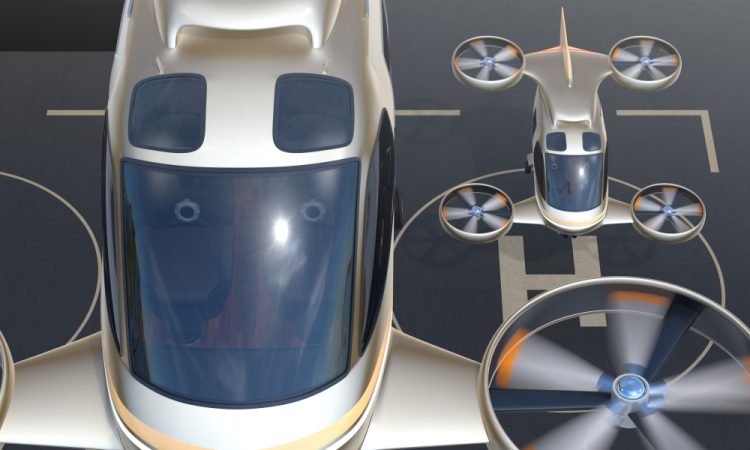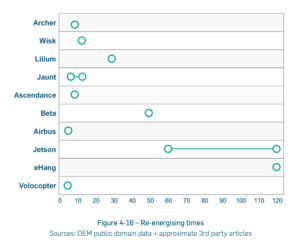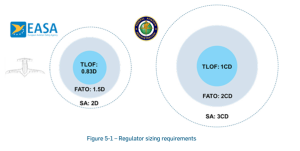Among the conclusions:
- “Aircraft dimensions influence the creation of safe, effective infrastructure. Compatibility of infrastructure between various eVTOL aircraft types and conventional helicopters will vary depending upon the design specification of the Vertiports. Conservative sizing for the largest expected dimensions will maximise futureproofing and safety but at the compromise of site area efficiency.”
- “The absence of verified information may lead to oversizing for safety. Regulatory approaches are evolving from ICAO Annex Vol II by considering the “Minimum Closing Circle” rather than the largest overall dimension of the aircraft. In the absence of data reported by the OEMs, this value must be conservatively estimated resulting in inefficient infrastructure design.”
- “Novel designs will create novel effects – further research will be required to understand this. Propulsor configurations with high disc-loading will have significantly reduced hover performance compared to helicopters, requiring special consideration for take-off and landing profiles, particularly in dense urban areas. These configurations may also impact the downwash profiles, but little research exists to quantify this impact.”
- “Effective operations require knowledge sharing to define suitable procedures. A large gap exists in the details of required ground operations which has notable implications for supporting stakeholders. Vertiport designers and operators will need to derive procedures for towing, re-energising, and maintenance, all of which will be based on the aircraft specific requirements. Adding to this complexity, clarity will be required on how each operation fits under the existing regulatory framework.”
Here are some of the other more granular problems the study has identified:
Re-charging times
- “Of all the ground operations required for aircraft turnaround at the Vertiport, re-energising time is the mostly widely publicised, yet is not widely available in the public domain. Figure 4-16 shows how reported re-energising time varies. There is no standard definition for how recharging time should be reported so there could be variation between OEMs over whether they consider this to be a full charge, or to ~80% which might be sufficient for many uses.
“Of the analysed aircraft, only Volocopter aim to use battery swap to re-energise, and hence present the lowest theoretical time. For a given route, the reduced range Multicopter configuration will reach a reduced state-of-charge more quickly compared to winged competitors, associated with lengthy recharging times and a significant impact on aircraft utilisation which impacts viability. Battery swapping could therefore be essential to maximise their throughput at Vertiports. The consequence of this however is the reliance on the infrastructure to provision for battery swapping support equipment and associated skilled staff at each Vertiport with procedures in place that could slow the process down further.”
Vertiport design
“The wingspan and aircraft lengths are vitally important to calculate the critical dimensions for sizing TO/L infrastructure. The eVTOL “Minimum Closing Circle” or “Controlling Dimension” (D) is a new parameter defined to standardise the approach to sizing Vertiports on the basis that the “largest overall dimension” will not necessarily encompass the entire defined area of the aircraft…. The largest Minimum Closing Circle values is found to be 17.6m for the Beta Alia aircraft, whereas the smallest one was for Jetson ONE at 2.5m. In keeping with mass comparisons, Multicopters again are found to be smaller than the winged eVTOL. This dimension is an important value for Vertiport designers to consider ensuring all first-generation eVTOL configurations can be accommodated for. Most Minimum Closing Circle values for eVTOL are higher than the Robinson R44, highlighting the importance of reviewing existing helipad sizing against eVTOL requirements for compatibility…. The “Minimum Closing Circle” is proposed instead to fully encompass the shape of eVTOL aircraft and avoid obstacles. In this study, a worst-case estimate was derived with a scaling factor from EASA. Improving this accuracy with actual dimensions, including undercarriage width, from the OEMs will be essential to maximise efficiency in the infrastructure footprint. With this dimension, the Vertiport elements can be sized following precedent set by the heliport documentation as per Figure 5-1.
“… Compatibility with heliports is not just a matter of loading; the sizing of TLOFs, Final Approach and Take-Off areas (FATOs) and taxiways is equally important. In fact, this will be the greatest difference considered due to the novel configuration and dimensioning of the aircraft…. best practice in ICAO Annex 14 Vol II to use the largest overall dimension to size infrastructure requires modification.”
Fly by wire flight control systems
“Although FbW is considered the preferred option for the OEMs, it still poses limitations. It is common for aircraft to have bundles of copper wires which introduces strenuous maintenance delays during fault isolation. Whilst FbW systems are far lighter than mechanical systems, they are still considered to be heavy due to the amount of copper cabling involved alongside caging from Electromagnetic Interference (EMI). The redundancy in the power system also must be improved, meaning more power generation redundancy along with wire weight could add further mass penalties. Volocopter is an outlier within the dataset as the only OEM planning to take advantage of a Fly-by-Light (FbL) system. FbL has opened the doors to a theoretically more robust EFCS, using light to transfer information through fibre-optic cables as opposed to electric signals via copper wires, offering the following advantages: › High bandwidth: Fibre optics offer potentially higher bandwidth than copper wires for faster data rates › Noise Immunity: Information transfer over long distances without signal degradation via EMI21. The main drawback of this system has been the material properties of the cables itself..
Take off profiles
“To enable operations in dense urban environments, there could be some difficulty in designing Vertiports with existing helicopter flight take-off profiles, and associated obstacle limitation surfaces. Whilst elevated sites may function suitably with traditional surfaces, ground-level sites are likely to struggle to become viable in the city landscape. To provide an alternate solution to this problem, EASA have proposed a new “Vertical take-off” profile that allows for a longer vertical climb as per Figure 5-2. This method allows the aircraft to operate in denser environments and requires a new obstacle definition for the Vertiport designer. The viability of these manoeuvres will depend on the aircraft configuration and design…. For instance, aircraft with a high disc-loading and poor hover efficiency will not be able perform an extended VTOL flight phase without draining battery reserves; this manoeuvre instead favours the Multicopter configuration. This could impose operational limitations on some aircraft determining whether they are permitted to use certain urban Vertiports.”
For more information
https://publicapps.caa.co.uk/modalapplication.aspx?appid=11&mode=detail&id=11916
(Image:Shutterstock)







